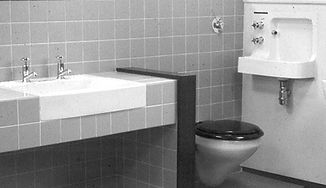barbican basin.com
Designed for the Grade II listed Barbican Estate, one of London's best examples of British Brutalist architecture
History of the Twyford's Barbican Basin
Barbican Basin & the Barbican Estate
What are the origins of the Barbican Basin sink?
The iconic Barbican Handrinse Basin was designed for the Barbican Estate in London.
Chamberlin, Powell and Bon were appointed architects for the Barbican scheme in 1960. The construction of the residential estate commenced during the 1960's and the first building, named Speed House, officially opened in 1969. The construction of the housing development continued throughout the 70's and the Barbican Centre was finally completed in 1982. The complex houses around 4000 people over 2014 flats.
The Barbican has been designated a site of special interest and became Grade II listed in September 2001. The enormous, imposing concrete structures of the buildings remain to provide a very prominent example of British brutalist architecture.
The architects Chamberlin, Powell and Bon were equally involved with the finer details of the fixtures and fittings in the flats, as they were with the interior layout of the scheme. In 1961 new housing standards were introduced which required a hand basin in any WC that was separate from the bathroom. The new regulations created a concern over the limited space within the flats and it was decided that a bespoke, space saving, compact washbasin was required. Chamberlin, Powell and Bon discussed the basic principles of the concept which led to a design brief being passed to German trained architect, Michael Hohmann.
The Barbican Handrinse Basin
Who designed the Barbican Basin sink?
The Barbican handrinse basin was designed by Michael Hohmann in the early 1960's. Hohmann visited Twyfords Cliffe Vale factory and presented a range of designs that were required for the Barbican Estate. These included a countertop washbasin, space saving handrinse basin, urinal and wall hung wc.
The ideas were presented in a conceptual, sketchy 'back of the envelope' format, however Hohmann was very clear and precise in what he wanted as a final product. Twyfords experts discussed the concepts and due to the requirement for straight edges, it was suggested that the washbasins would be more suitable in white enamelled steel. Hohmann insisted Twyfords applied their expertise to the challenge because he required the whole range to be in the same white vitreous china material.
Munroe Blair, then Twyfords young designer with an architectural training background, translated the sketch proposals into working drawings. Hohmann was very pleased with the full size drawings which were used by the modeller to produce a full size plaster model of the Barbican handrinse basin.
The architects then required fired samples to be installed within a full size bathroom mock up. The samples were cast, fitted and approved, thus securing the huge contract order for the Barbican Estate.
The production of models and moulds coupled with the adaptions required to perfect the products was a very timely and costly development exercise. Munroe Blair estimates that it was around a six month period to reach final production from the initial enquiry stage,
The Barbican washbasin designs were products of innovation in manufacturing terms, venturing into the impossible and unknown at the time for ceramic manufacture. Although the Barbican handrinse had a simple uncomplicated form, it relied upon modelling expertise to achieve the distortion free straight sides to match the cast concrete structure. It was Twyfords who were world leaders in the industry that persisted with arresting and harnessing the distortion and contraction idiosyncrasies of the vitreous china material that made the product a reality.
The ground breaking modern Barbican basin went into production in the early nineteen sixties and was installed throughout the Barbican flats.
In 1963 the Sola hand washbasin by Twyfords was the first sanitaryware washbasin to win a Council of Industrial Design award. The Barbican handrinse basin became the second, winning a Design Centre Award in 1966.
What versions of the Barbican Basin were available?
The basin was initially offered in left and right handed versions and only in white. Later in 1972, for wider commercial sales, five standard colours were introduced: shell pink, sky blue, primrose yellow, pampas and turquoise. Avocado wasn't introduced until 1975 and then later during the early 1980's the basin was produced in a variety of new colours which were introduced by Twyfords who were leading the way in introducing colour to the bathroom.
The right handed tap arrangement and foot operated versions were discontinued in about 1978 and in later years the colours were withdrawn and so the Barbican was only available in a white, left handed tap arrangement. Although Twyfords was acquired by Reed International in 1971, by MB Caradon in 1989, by Sanitec in 2001 and finally Geberit in 2015, the Barbican basin remained in production for over 50 years. It was finally discontinued under Geberit in 2017 with an official de-listing date of 4th August 2017.





Barbican, 1969: The development of the Barbican Estate following World War II

The Barbican Estate

The Barbican: A Middle Class Council Estate
